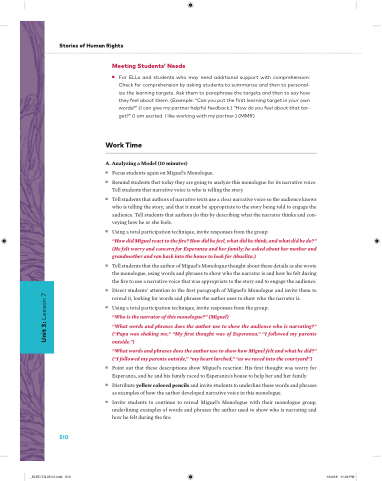Page 534 - EL Grade 5 Teacher Guide
P. 534
Stories of Human Rights
Meeting Students’ Needs
■ For ELLs and udents who may need additional support with comprehension: Check for comprehension by asking udents to summarize and then to personal- ize the learning targets. Ask them to paraphrase the targets and then to say how they feel about them. (Example: “Can you put the r learning target in your own words?” (I can give my partner helpful feedback.) “How do you feel about that tar- get?” (I am excited. I like working with my partner.) (MMR)
Work Time
A. Analyzing a Model (10 minutes)
■ ■
■
■
■
■
■
■
■
■
Focus students again on Miguel’s Monologue.
Remind students that today they are going to analyze this monologue for its narrative voice. Tell students that narrative voice is who is telling the story.
Tell students that authors of narrative texts use a clear narrative voice so the audience knows who is telling the story, and that it must be appropriate to the story being told to engage the audience. Tell students that authors do this by describing what the narrator thinks and con- veying how he or she feels.
Using a total participation technique, invite responses from the group:
“How did Miguel react to the re? How did he feel, what did he think, and what did he do?” (He felt worry and concern for Esperanza and her family; he asked about her mother and grandmother and ran back into the house to look for Abuelita.)
Tell students that the author of Miguel’s Monologue thought about these details as she wrote the monologue, using words and phrases to show who the narrator is and how he felt during the re to use a narrative voice that was appropriate to the story and to engage the audience.
Direct students’ attention to the rst paragraph of Miguel’s Monologue and invite them to reread it, looking for words and phrases the author uses to show who the narrator is.
Using a total participation technique, invite responses from the group:
“Who is the narrator of this monologue?” (Miguel)
“What words and phrases does the author use to show the audience who is narrating?” (“Papa was shaking me,” “My rst thought was of Esperanza,” “I followed my parents outside.”)
“What words and phrases does the author use to show how Miguel felt and what he did?” (“I followed my parents outside,” “my heart lurched,” “as we raced into the courtyard”)
Point out that these descriptions show Miguel’s reaction: His rst thought was worry for Esperanza, and he and his family raced to Esperanza’s house to help her and her family.
Distribute yellow colored pencils and invite students to underline these words and phrases as examples of how the author developed narrative voice in this monologue.
Invite students to continue to reread Miguel’s Monologue with their monologue group, underlining examples of words and phrases the author used to show who is narrating and how he felt during the re.
510
_ELED.TG.05.01.indb 510
12/4/18 11:49 PM
Unit 3: Lesson 7


